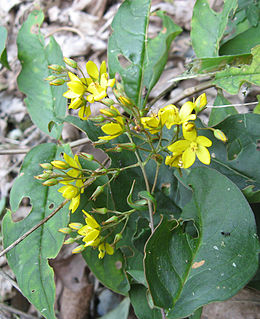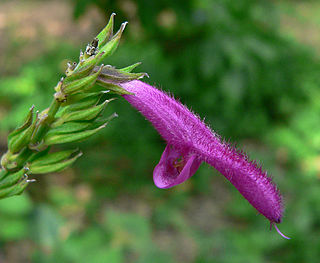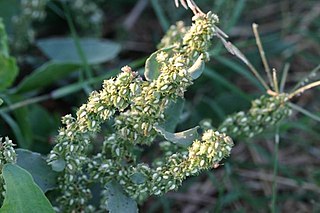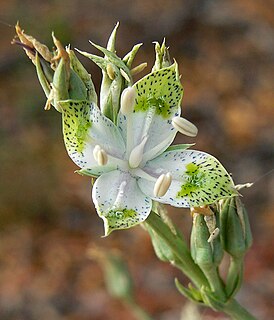
Persicaria bistorta or Bistorta officinalis is a species of flowering plant in the dock family Polygonaceae native to Europe and north and west Asia. The generic placement of this species is in flux. While treated here in Persicaria, it has also been placed in Polygonum or Bistorta. Other common names include snakeroot, snake-root, snakeweed and Easter-ledges.

Lathyrus japonicus is a legume native to temperate coastal areas of Asia, Europe, and North and South America.

Rumex obtusifolius, commonly known as bitter dock, broad-leaved dock, bluntleaf dock, dock leaf or butter dock, is a perennial weed in the family Polygonaceae. It is native to Europe but can now be found in the United States and many other countries around the world such as Australia and New Zealand.

Rumex longifolius, commonly known as the dooryard dock or northern dock, is a perennial species of plant in the genus Rumex.

Lathyrus vernus is a species of flowering herbaceous perennial plant in the genus Lathyrus, native to forests of Europe and Siberia. It forms a dense clump of pointed leaves with purple flowers in spring, shading to a greenish-blue with age.

Lysimachia fraseri is a rare species of flowering plant in the primrose family known by the common name Fraser's yellow loosestrife. It is native to the Southeastern United States, where it is listed as an endangered species in several states.
Salvia candidissima is a herbaceous perennial native throughout western Greece, and parts of Turkey, Iraq, and Iran, generally between 2000 and 6500 feet elevation. Several small stems grow almost horizontally from the roots before bearing upright inflorescences. The plant reaches 3 ft in height and width in the wild. The light green leaves, 6 in long by 4 in wide, are covered with hairs on both sides and often have notches on the edges. The leaves become lighter in color as the weather gets hotter. The 8–12 inch inflorescences are branched, with 1 inch flowers in whorls that are creamy white and sometimes tipped with a yellow lip. Salvia candidissima is one of a group of seven salvias that are closely related, grow in the same habitat, and easily hybridize with each other, resulting in a great deal of variety in the species.

Salvia iodantha is a herbaceous perennial native to the mountains of central Mexico, growing between 2,600-10,500 ft elevation. It was described by Merritt Lyndon Fernald in 1900 and began appearing in horticulture in the 1980s.

Rumex stenophyllus is a species of flowering plant in the knotweed family known by the common name narrowleaf dock. It is native to Eurasia and it can be found in parts of North America as an introduced species and roadside weed. It grows in moist and wet habitat, often in areas with saline soils. It is a perennial herb producing an erect stem from a thick taproot, usually measuring 40 to 80 centimeters tall, but known to well exceed one meter. The leaves are up to 30 centimeters long and are generally lance-shaped with curled edges. The inflorescence is an interrupted series of clusters of flowers with 20 to 25 in each cluster, each flower hanging from a pedicel. The flower has usually six tepals, the inner three of which are largest, triangular and edged with teeth, and bearing tubercles.
Rumex dentatus is a species of flowering plant in the knotweed family known by the common names toothed dock and Aegean dock. It is native to parts of Eurasia and North Africa, and it is widely known elsewhere as an introduced species. It grows in disturbed habitat, often in moist areas, such as lakeshores and the edges of cultivated fields. It is an annual or biennial herb producing a slender, erect stem up to 70 or 80 centimeters in maximum height. The leaves are lance-shaped to oval with slightly wavy edges, growing to a maximum length around 12 centimeters. The inflorescence is an interrupted series of clusters of flowers, with 10 to 20 flowers per cluster and each flower hanging on a pedicel. Each flower has usually six tepals, the 3 inner of which are edged with spinelike teeth and have tubercles at their centers.
Rumex kerneri is a species of flowering plant in the knotweed family known by the common name Kerner's dock. It is native to Europe. It has also been observed in California as an introduced species and roadside weed. It is a perennial herb producing a slender, erect stem from a thick taproot, approaching 1.5 meters in maximum height. The lance-shaped leaves can be up to 25 centimeters long and have smooth, wavy, or wrinkly edges. The inflorescence is an interrupted series of clusters of flowers, with 15 or 20 in each cluster, each flower hanging from a pedicel. The flower has usually six tepals, the inner three of which are largest, about 6 millimeters long, edged with tiny teeth and bearing rounded tubercles in the centers.

Rumex pulcher is a species of flowering plant in the knotweed family known by the common name fiddle dock. It is native to Eurasia and North Africa and it can be found elsewhere, including parts of North America, as an introduced species and a roadside weed. Europe. It is quite variable in appearance, and some authorities divide it into several subspecies that are more or less distinguishable. In general, it is a perennial herb producing a slender, erect stem from a thick taproot, approaching 70 centimeters in maximum height. The top of the plant may bend, especially as the fruit develops. The leaves are up to 10 or 15 centimeters long and variable in shape, though often oblong with a narrow middle in the rough shape of a fiddle. The inflorescence is made up of many branches, each an interrupted series of clusters of flowers with up to 20 in each cluster, each flower hanging from a pedicel. The flower has usually six tepals, the inner three of which are edged with teeth and have tubercles at their centers.

Rumex salicifolius is a species of flowering plant in the knotweed family known by the common names willow dock and willow-leaved dock. It is native to much of western North America and it can be found in parts of Europe as an introduced species and a roadside weed. It is an extremely variable plant which is generally divided into many varieties, some of which may actually be specimens of other species. In general, it is a perennial herb producing a slender stem which is prostrate and spreading or erect, growing up to about 90 centimeters in maximum length. The leaves are up to about 13 centimeters long and can be most any shape. The inflorescence is an interrupted series of clusters of flowers, with up to 20 in each cluster, each flower hanging from a pedicel. The flower has usually six tepals, the inner three of which are largest and usually have central tubercles. It is an important food and host plant for Lycaena rubidus larvae.

Rumex venosus is a species of flowering plant in the knotweed family known by the common names veiny dock, winged dock, and wild-begonia. While not of any particular agricultural use, its cousins rhubarb and buckweat are. It is native to central and western North America, from southern parts of the Canadian prairies, through to Mexico.

Frasera albomarginata is a species of flowering plant in the gentian family known by the common name desert green gentian, or desert frasera.

Gentiana glauca is a species of flowering plant in the gentian family known by the common names pale gentian and glaucous gentian. It is native to eastern Asia and northwestern North America from Alaska to the Northwest Territories to Washington and Montana.
Rumex orthoneurus is a species of flowering plant in the knotweed family known by the common names Chiricahua Mountain dock and Blumer's dock. It is native to western North America, where it can be found in Arizona, New Mexico, and Sonora.

Rumex alpinus, common name monk's-rhubarb, Munk's rhubarb or Alpine dock, is a leafy perennial herb in the family Polygonaceae. It is native to upland areas of Europe and Western Asia.
Rumex pseudonatronatus, common name field dock or Finnish dock, is a plant species native to northern Europe and northern Asia, known from Asiatic and European Russia, China, Mongolia, Kazakhstan, Kyrgyzstan, Finland, Norway, Sweden, Belgium, Netherlands, Estonia, Latvia, Lithuania, Poland, Belarus, etc. It is naturalized in much of Canada and to the north-central United States. It is known from every Canadian province from Québec to British Columbia, plus Yukon, North Dakota, South Dakota and Minnesota. It grows in wet and/ore disturbed sites along stream banks, lake shores, roadsides, ditches, cultivated fields, meadows, etc.



















